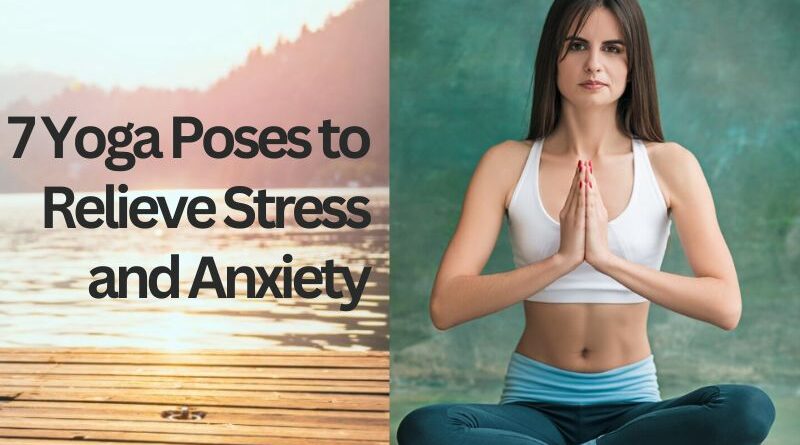Find Inner Peace: 7 Yoga Poses to Relieve Stress and Anxiety
Yoga Poses For Stress Relief: Stress is a silent illness spreading all around. Stress is not a health-friendly guest whom we should welcome in our life. We need to tackle stress so we can live happily and work according to our full potential. Yoga is a blessing for this modern work and one of the effective ways to manage and relieve stress.
Yoga – Easy to adopt with Unlimited Benefits
- It is easier to adopt as you just need a mat and you are ready to start it
- No need to do complex poses. Simple poses can help you relieve stress
- Easy on the body and with lesser chances of injury, you need to do it mindfully and at a slow pace
- Yoga can be started by all age groups under guidance
7 Calming Yoga Poses For Stress Relief
In a study conducted on 52 women with ages between 33.5 to 41. Their depression, anxiety, and stress decreased significantly after they practiced hatha yoga practice for 12 regular sessions. Nowadays, stress is present daily. It ranges from mild to high levels which significantly impact the functioning of day to day life. Practicing yoga can help you shake off the stress. Deep breathing and stretching done during yoga asanas help reducing stress which we store in various joints and muscles as well. Sharing with you easy yoga poses to start your journey.
Stress-relieving yoga poses
Here are stress-relieving yoga poses which can be practiced daily
Stick Pose:
- Legs stretched, feet together, lie faceup on the floor.
- Spread your arms out over your head until they are parallel to one another and rest on the ground.
- Breathe in, then extend your body as far as you can from this position, reaching with your fingers and toes as though you were reaching for something at either end of your body.
- Deeply inhale as you hold for five to ten seconds. Repeat two or three times after letting go.
Benefits
- This asana relaxes some of the muscles that impact posture
- Improves circulation of your body
- Deep breathing eases stress
Cat cow Pose:
How to do the pose:
Cat Pose
- Starting from your four limbs is necessary.
- Breathe out, turn your back to face the ceiling, and raise your navel up against your vertebrae.
- Return to neutral; the head and spine should be in line.
Cow Pose
- Take a breath and raise your tailbone by tilting your pelvis back
- Draw your navel in and maintain your abdominal muscles embracing your spine
Benefits of this pose:
- Asana massages the spine and relieves stress from it
- Stretches the lower back
Read Also: Tips on Food to Avoid for Acidity, Gas and Constipation
Childs pose:
How to do the pose:
- Place your legs together on a yoga mat, kneel, and then gradually return to your heels.
- Bend forward from the hips and extend your torso so that your forehead is on the ground in front of you and your chest is resting on your thighs.
- Turn your shoulders to the sides and place your hands palms up by your feet. For five to six breaths, maintain this posture.
- Give up all of the world’s troubles while you take a few deep breaths and hold this position for a while.
Benefits of this pose:
- It elongates the back and stretches the hips, thighs, and ankles in addition to being calming and relaxing.
- Quietens the nervous system and lymphatic system
- Child pose resting posture eases stress and soothes the mind.
Easy Pose:
How to do the pose:
- With your back against the chair and your legs out in front of you, sit up straight, placing each foot under the knee of the person on the other side, and cross your legs in front of your body
- Put your hands on your knees with the palms facing down
- Sit with your weight evenly distributed and align your head, neck, and spine
- Lengthen your back while bending your neck and letting your thighs and feet drop a little
- After maintaining this posture for about a minute, slowly release your hold and adjust the way your legs cross
Benefits of this pose:
- Opens hips and lengthens spine
- It relieves physical and mental exhaustion
- Eliminates anxiety
Legs Up the Wall:
How to do the pose:
- Facing a wall, take a seat on the ground
- Lying on your side, lower your head and shoulders to the ground
- Turn over onto your back and extend your legs along the wall, placing your feet hip-width apart or at a comfortable distance between them
- Tilt your tailbone in the direction of the wall. It is not necesssary to touch the wall
- Arms should be on sides with palms facing up. You need to be in a comfortable position
Benefits of this pose:
- Helps restore equilibrium after extended periods of standing
- Improves circulation in the upper body
- Helps your legs release lymphatic fluid, which will lessen swelling in your knees, ankles, and feet
- Helps with your sleep and calms your nerves
Head to knee forward bend:
How to do the pose:
- Stretch your legs straight out in front of you, sit up straight, and place the ball of your left foot against the inner of your right thigh
- Your left knee needs to be flat on the ground
- Place your hands on either side of your right leg and take a deep breath
- Fold forward, turn to face the extended leg, and release your breath
- After holding the pose for five to six breaths
- Repeat same steps with left leg
Benefits of this pose:
- It helps in calming your mind
- Beneficial for mild depression and anxiety
- It is also helpful with headaches, fatigue, and insomnia
Corpse pose:
How to do the pose:
- Lie flat on your back with your legs close together but not touching.
- Place your arms at your sides with your palms facing up
- Close your eyes and take a deep breath
- Focus on every body part one at a time starting from head to toes
- Stay four to five minutes in this claiming posture
Benefits of this pose:
- Creates a calming effect in your body
- Quietens the nervous system and helps build immunity
- Reduces depression and anxiety
Conclusion
Yoga has a calming impact on the body and mind. It brings about a balance in your system. You can try the calming poses and see the benefits on your own. People around the world have benefitted from yoga and it’s not at all surprising that people turn to yoga as an alternative therapy for healing.
Disclaimer: This article is for informational purposes only and does not constitute medical advice. Always consult with your doctor before starting any yoga program. Also, Please take guidance from certified yoga teachers.
Read Also: The Benefits of Intermittent Fasting: From Weight Loss to Mental Clarity




